Rice and tahini pudding (Mufattaka)
September 22, 2013 • Category: Dessert
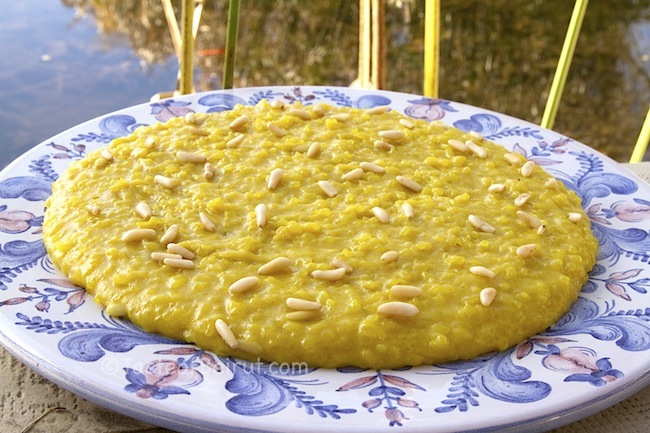
Mufattaka is a glorious rice pudding only familiar to folks who have lived in the oldest traditional Beirut neighborhood called Ras Beirut (Ras is the tip of Beirut or West Beirut, the oldest part of the city).
Hind had been living in this area for over fifty years, in the same home; she told me about it as a special treat she grew up with and of course, I wanted to taste it. She said everybody in her community loved this mufattaka (in Lebanese, the word describes something unraveled, as the rice pudding is cooked so long it becomes soft and chewy).
Like other popular street foods, it is made up of just a few ingredients; rice, tahini, sugar and turmeric; sprinkled with pine nuts, and served at room temperature. Makari and Hashem who still make this old-fashioned treat today do not skimp on the time and told me it takes them six hours of stirring.
I made it at home in under one hour; well, truthfully, theirs had a better texture, but I was pleased with the taste of mine. I have done risotto in stages before, no need to be intimidated; you can start over the next day, add more water and stir some more.
INGREDIENTS: 4 to 8 servings
- 1 cup of rice (Egyptian or Italian or sushi or any medium-starchy rice)
- 1 cup of tahini
- 1 3/4 cup of white granulated sugar
- 3 cups of water
- 1 Tbsp. of turmeric
- ½ cup of pine nuts, soaked in a bowl of cold water for one hour or longer
1. Place rice in bowl and soak in water overnight. Drain rice and transfer to a heavy-bottom saucepan (pick one large enough to hold at least 4 cups of liquid). Add 3 cups of water and bring mixture to a boil; lower the heat to the max and let the mixture simmer for 45 minutes, stirring from time to time.
2. Add the turmeric and stir; add the tahini and sugar and stir. Stir every few minutes for another 45 minutes. Add the ¼ cup of pine nuts and stir to spread them around the pudding. When the pudding is very thick, rice is soft and the tahini is completely melded into the rice, it is ready. The tahini can at this point separate with the oil coming up to the surface, but it is not absolutely necessary.
3. Transfer the mufattaka to a serving platter and garnish with the remaining pine nuts.
NOTE: Siham, beauty shop owner in Beirut, says that she adds a touch of anise to her mufattaka.
Side note: I am wondering if mufattaka will still be in demand ten, twenty, years from now? or is it just going out permanently? I have seen it in delis in West Beirut, sold next to plain rice puddings, muhallabieh or custards or spice puddings.
Hard at work, stirring the pudding.
Pick up a plate, eat it and return the next day emptied.
In this mufattaka, the pine nuts are cooked along with the rice at the end.
Comments
27 Comments • Comments Feed

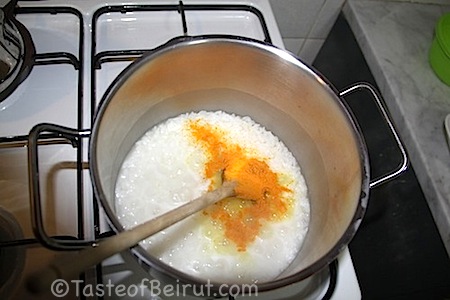
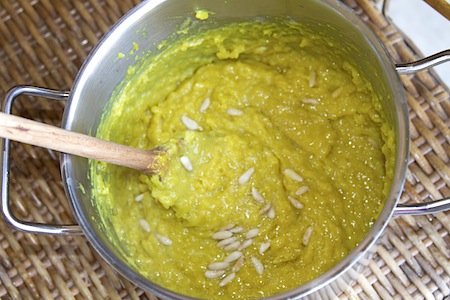
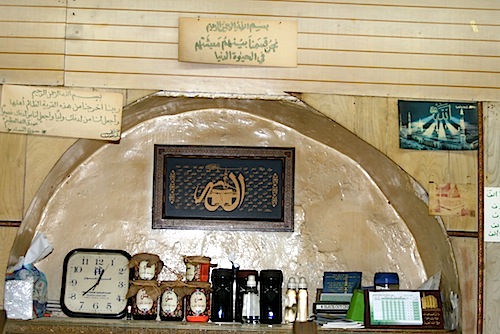

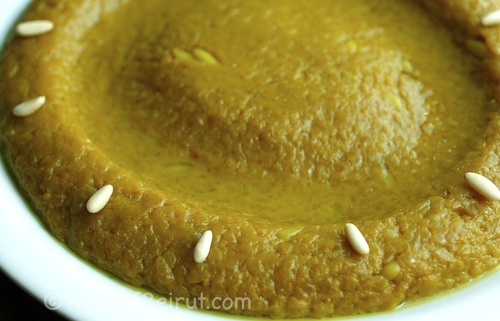
Paula Mello says:
Very interesting, Joumana! It is a pity that many traditions have been lost over time due to the rush of modern life. Maybe twenty years from now, someone is still making this recipe because they met here. Would not it be amazing?
On September 22, 2013 at 6:32 am
Rosa says:
A delicious looking and sounding pudding! That is such an interesting combination.
Cheers,
Rosa
On September 22, 2013 at 6:51 am
Angie@Angiesrecipes says:
Turmeric has given the rice pudding such a gorgeous golden colour. Yum!
On September 22, 2013 at 8:09 am
Gabi says:
Turmeric in a sweet pudding is surprising. Must be tried on a proper occasion. Six hours of stirring without the thing burning at the bottom of the pan will be a challenge time-, pan- and ovenwise. Think I’ll try something in my crockpot or the interruption method.
Well, the internet is after all very helpful in sharing and keeping, so hopefully this will not be forgotten and more of it will follow. Thanks for sharing.
On September 22, 2013 at 8:16 am
Anonymous says:
The color is way off; it looks more like mjadrah than mfatqah.
I don’t see your point behind the question whether or not people will continue to make mfatqah 10 or 20 years down the road. The question is generic and can be applied to anything. For example, will people keep on making Kishk 10 or 20 years down the road? Kishk does take more time and more effort than mfatqah.
On September 22, 2013 at 8:18 am
Tina Aboulkhoudoud says:
A friend made this for us for dessert . I was skeptical at first as it looked so different !
What a amazing combination ! Love it so much .
On September 22, 2013 at 9:39 am
Walter de Neergaard says:
I think of adding a few drops of “May Zahar” … citrus Water to this 😀
On September 22, 2013 at 10:52 am
Nathalie Saky says:
I think it is a great desert. One more dairy free rich in taste recipe. I will definitely try it. The color reminds me sfoof and certainly not mujadarrah.I didn’t knew about Muffattaka before discovering it in your blog.I wouldn’t be surprised that it may get lost over time. Thanks to you, Joumana, valuable culinary traditions are shared and taught. Thank you.
On September 22, 2013 at 5:16 pm
Mark Wisecarver says:
Marvelous! The photos are all great too.
I’m a bit surprised there isn’t a bit of hub-al-hal in there and I have to admit I’m partial to toasted snoober but for this I will try them soaked. 😉
On September 22, 2013 at 7:03 pm
Nuts about food says:
The first picture looked like a risotto alla milanese to me. Seven hours of stirring requires a lot of patience, but it does sound like a real treat. I can see how creamy it gets by the end of those hours.
On September 23, 2013 at 1:31 am
Belinda @zomppa says:
The best is when things are simple!
On September 23, 2013 at 12:06 pm
E. Nassar says:
I love it when you highlight these less than common or – to me- unknown Lebanese recipes. This sounds really good. I have to try it soon.
BTW, this looks nothing like mujadarra, It’s yellow! to each their own I suppose…
On September 23, 2013 at 5:37 pm
Hélène (Cannes) says:
Je n’aurais jamais imaginé mettre du tahini dans un gâteau de riz. Et le curcuma qui donne une si jolie couleur toute dorée … Je note dans un coin tout de suite ! Je dois absolument goûter !
Bisous
Hélène
On September 24, 2013 at 9:43 am
Oui, Chef says:
Gorgeous color to this dish. So hard to beat a good rice pudding, don’t you think?
On September 24, 2013 at 2:50 pm
Mary says:
In Iran we make something similar with starchy rice, saffron , rose water, sugar, and use pistachio, silvered almonds and cinnamon for decoration, it is called ” شله زرد” ” shole Zard”, it takes only 20 – 30 minutes.
On September 24, 2013 at 6:49 pm
Alicia (foodycat) says:
This looks lovely! And it’s always useful to have a few vegan recipes up your sleeve.
On September 28, 2013 at 6:14 am
Fawn says:
This looks right up my alley. I’m a sucker for anything tahini. When I was a kid, my parents would give it to me instead of peanut butter because I didn’t like peanut butter (that’s changed since then!) so it always reminds me of being a child. Tahini with wildflower honey on toast, true love.
On October 5, 2013 at 1:48 pm
Jamie says:
Glorious indeed! What an amazing and unique pudding! Oh I hope dishes like this remain for generations…. This one is an unusual mix of ingredients and the texture looks heavenly.
On October 6, 2013 at 9:52 am
paty says:
I have never heard nor tried this beauty! I wanted to ask, if I want to substitute the white sugar, can we with let’s say dates or honey? Or it is better to stick with the sugar? And if I can substitute it, what’s the ratio? Thanks Joumana!
On October 7, 2013 at 1:52 am
Joumana says:
@paty: i would not substitute here because the entire taste would be lost; this dessert is really about turmeric and tahini and sugar.
On October 9, 2013 at 3:44 am
Sarah says:
I remember mama using a pressure cooker midway, got the “right” texture but cut down stirring time, I can almost taste it, heaven…
On October 7, 2013 at 8:36 pm
Imad says:
Anonymous you are stupid and envious. This is a blog, she can say whatever she wants, dumbass.
On October 16, 2013 at 1:40 pm
Anne-Marie says:
Thanks Joumana, for constantly being on the look out for long forgotten recipes. It’s what sets your website/ blog apart form others! Can’t wait to try it.
By any chance, did your ever run across the reason behind the curious name moufattakah (“come apart, torn”?)…thanks!
On October 17, 2013 at 1:21 pm
Joumana says:
@Anne-Marie: yes the man who makes this for a living told me it is because the constant stirring 6 hours+ makes the rice fall apart and meld into the sauce; it it becomes the texture of taffy (not mine, I don’t have that kind of patience!).
just like another old-fashioned dessert is just the opposite and called mubattaneh, buttoned-up; it is rice pudding topped with juice pudding so the rice pudding is locked inside underneath.
On October 18, 2013 at 12:48 pm
Umm osman says:
Thank you so much for this recipe!!!
On October 23, 2013 at 4:54 pm
perla says:
I was just talking about this dessert last night with a lebanese lady that happen to be a food blogger too. She has never heard of it ( been to lebanon only once ). I’m currently at the airport travelling across the country to see her and we will be making this dessert together because well , we are curious and ‘4 hands is better than 2 for stirring ! Can’t wait!
On February 23, 2024 at 4:30 pm
Joumana Accad says:
@perla yes, I had never heard of it either while growing up and only found out about it because I had a friend who was from this neighborhood of old Beirut. I am warning you though that it is hard to make (a lot of stirring) and the taste is… a bit of an acquired taste. If you like turmeric and tahini, you will like it!
On March 5, 2024 at 7:10 pm